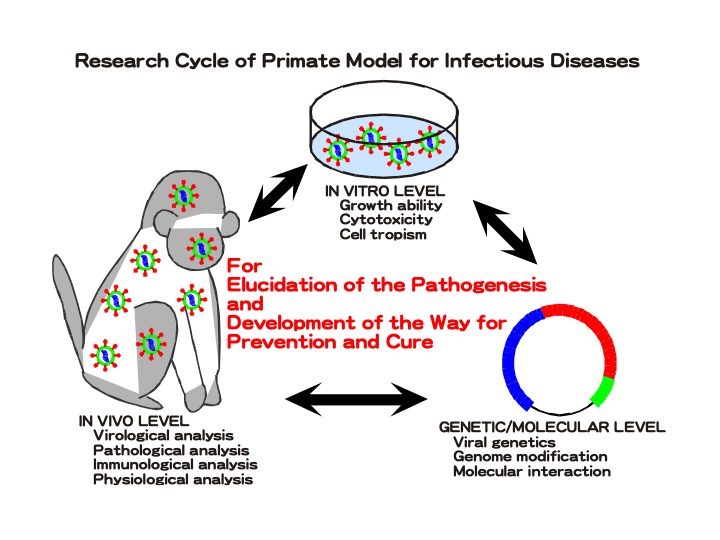
Tomoyuki Miura
Associate Investigator
- Position
- Associate Professor, Institute for Life and Medical Sciences, Kyoto University
- Research Field
- Virology
Research Overview
Elucidation of pathogenesis and development of preventive and therapeutic methods for infectious diseases using primate models
AIDS is a disease caused by the virus HIV-1. Since the disease was first discovered in the United States in 1982, it has spread from Africa, India, Southeast Asia, and Central America to the Caribbean and around the world, and the number of patients is increasing in Japan. AIDS is a tragic disease that destroys the mechanism called “immunity” that protects our body from bacteria and viruses.
A vaccine is a good preventive measure against diseases caused by viruses such as measles and influenza. With regard to HIV-1, it is thought that if we “immunize” the proteins growing on the surface of a virus (small particles that can only be seen under an electron microscope), we will not get the virus.
Before the vaccine can be made into a product, we have to find out whether it can prevent it or cause unexpected problems, and we use laboratory animals for such tests. HIV-1 cannot infect animals other than humans, so the vaccine cannot be tested in animals. Interestingly, a virus related to HIV-1 has been found in monkeys (called SIV). This SIV and HIV-1 gene can be recombined to make SIV with the protein growing on the surface of HIV-1 (called SHIV). This SHIV infects monkeys, so you can test in monkeys if the vaccine works against HIV-1. We were the first to make SHIV in the world and reported that SHIV can infect with monkeys.
A proper understanding of what AIDS is like is necessary for prevention and treatment, but animal models are essential for that. We are using SIV and SHIV to investigate why and how diseases occur. So far, it has been found that some SIVs and SHIVs cause severe illness and some are infected but do not cause illness. We are investigating why these differences occur by comparing viral genes and replacing them with other viral genes. We are also looking at the question of where and how much the virus is growing in the body, whether special cells are destroyed by the virus, comparing the virus causing disease and the virus not causing it.

Fig 1: Research Cycle of Primate Model for Infection Diseases
Biography
Tomoyuki Miura obtained his PhD from University of Tokyo (1988) and moved to Kyoto University (1988) as an Assistant Professor in the Institute for Virus Research. He was appointed Associate Professor in 1998. In 2016, the Institute for Virus Research and the Institute of Regenerative Medical Science were merged to become the Institute of Frontier Life and Medical Science. In 2022, the Institute name was changed to the Institute for Life and Medical Sciences.
Publications
Matsuura, K., Yamaura, M., Sakawaki, H., Himeno, A., Pisil, Y., Kobayakawa, T., Tsuji, K., Tamamura, H., Matsushita, S., and Miura, T.: Sensitivity to a CD4 mimic of a consensus clone of monkey-adapted CCR5-tropic SHIV-MK38C. Virology, 578: 171-179, 2023.
Pisil, Y., Yazici, Z., Shida, H., and Miura, T. Is SARS-CoV-2 Neutralized More Effectively by IgM and IgA than IgG Having the Same Fab Region? Pathogens, 10: 751, 2021.
Pisil, Y., Yazici, Z., Shida, H., Matsushita, S., and Miura, T.: Specific substitutions in region V2 of gp120 env confer SHIV neutralisation resistance. Pathogens, 9: 181, 2020.
Ishida, Y., Yoneda, M., Otsuki, H., Watanabe, Y., Kato, F., Matsuura, K., Kikukawa, M., Matsushita, S., Hishiki, T., Igarashi, T., and Miura, T.: Generation of a neutralization-resistant CCR5 tropic SHIV-MK38 molecular clone, a derivative of SHIV-89.6. J. Gen. Virol., 97: 1249-1260, 2016.
Matsuda, K., Inaba, K., Fukazawa, Y., Matsuyama, M., Ibuki, K., Horiike, M., Saito, N., Hayami, M., Igarashi, T., and Miura, T.: In vivo analysis of a new R5 tropic SHIV generated from the highly pathogenic SHIV-KS661, a derivative of SHIV-89.6. Virology, 399: 134-143, 2010.
Fukazawa, Y., Miyake, A., Ibuki, K., Inaba, K., Saito, N., Motohara, M., Horiuchi, R., Himeno, A., Matsuda, K., Matsuyama, M., Takahashi, H., Hayami, M., Igarashi, T., and Miura, T.: Small intestine CD4+ T-cells are profoundly depleted during acute infection of simian-human immunodeficiency virus regardless of its pathogenicity. J. Virol., 82: 6039-6044, 2008.
Kozyrev, I. L., Ibuki, K., Shimada, T., Kuwata, T., Takemura, T., Hayami, M. and Miura, T.: Characterization of less pathogenic infectious molecular clones derived from acute-pathogenic SHIV-89.6P stock virus. Virology, 282: 6-13, 2001.
Miura, T., Fukunaga, T., Igarashi, T., Yamashita, M., Ido, E., Funahashi, S., Ishida, T., Washio, K., Ueda, S., Hashimoto, K., Yoshida, M., Osame, M., B, S, Singhal., Zaninovic, V., Cartier, L., Sonoda, S., Tajima, K., Ina, Y., Gojobori, T. and Hayami, M.: Phylogenetic subtypes of human T-lymphotropic virus type 1 and their relations to the anthropological background. Proc. Natl. Acad. Sci., 91: 1124-1127, 1994.
Miura, T., Sakuragi, J., Kawamura, M., Fukasawa, M., Moriyama, E.N., Gojobori, T., Ishikawa, K., Mingle, J.A.A., Netty, V.B.A., Akari, H., Enami, M., Tsujimoto, H. and Hayami, M.: Establishment of a phylogenetic survey system for AIDS-related lentiviruses and demonstration of a new HIV-2 subgroup. AIDS, 4: 1257-1261, 1990.
Fukasawa, M., Miura, T., Hasegawa, A., Morikawa, S., Tusjimoto, H., Miki, K., Kitamura, T. and Hayami, M.: Sequence of simian immunodeficiency virus from African green monkey, a new member of the HIV/SIV group. Nature, 333: 457-461, 1988.
Joined
Apr. 1, 2020
